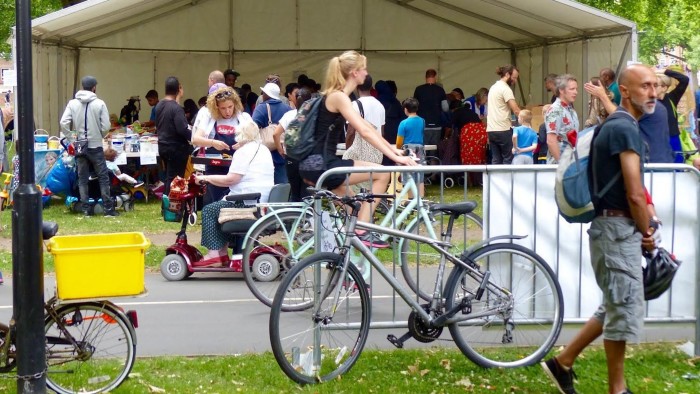Fix your iPhone — and everything else


Roula Khalaf, Editor of the FT, selects her favourite stories in this weekly newsletter.
When was the last time you repaired something?
The ethos of “make do and mend” may strike some readers as old fashioned. It is fair to say it reached its zenith at a time of national crisis. My parents — born in the early 1940s — can remember postwar rationing, which continued well into the 1950s. They are programmed not to throw anything away.
My dad once boasted he was wearing a pair of woollen hiking socks that were older than me. It wasn’t that he couldn’t afford another pair. There was a certain pride in looking after one’s possessions and, if necessary, prolonging their life with a stitch or two (in time, to save nine).
This spirit was also apparent in children’s TV programmes when I was growing up. Who can forget the thrifty mice from Bagpuss, whose squeaky voices chorused “We will fix it” as they repaired damaged antiques retrieved by Emily, the mysterious child shopkeeper? Or the Wombles of Wimbledon Common? (Altogether now: “Making good use of the things that we find / Things that the everyday folks leave behind”).
Back in the day, if a kitchen appliance went wrong, you called the local repairman. Nowadays, you just whip out your smartphone and order a new one.
Globalisation has given us cheap imports, resulting in price deflation and a vastly shortened replacement cycle. New products are so cheap, it is generally uneconomic to pay someone to fix things if they break. Over time, we have gradually lost the skills passed down by previous generations of fixing things ourselves.
But the backlash has begun, as I discovered recently when I attended a “restart party”.
The concept of this growing movement is simple: to “fix our relationship with electronics”. People with broken printers, laptops, fans, vintage record players and other gadgets queued to enter a marquee in our local park where volunteer “fixers” showed them how their possessions could last for years longer with a simple repair.
Organised by the Restart Project, a London-based social enterprise, the objective is not just saving money — it is also about saving the planet.
Restart party hosts around the world have saved an estimated five tons of electronic items from being thrown away. This sounds impressive — until you realise that we are projected to create 50m tons of waste from electrical goods globally in 2018. These figures have been crunched ahead of the first international “Fixfest” in October, where makers, designers, activists and tinkerers will gather in London to spread the word about why repairing matters.

Restart party organisers are frustrated that about half of the objects people bring along to their events cannot be successfully repaired. Things nowadays are not built to last. Walking around in a pair of 30-year old socks might be good for the planet, but it is not good for businesses that want to sell you more socks (or for a UK economy propped up by consumer spending).
And so the concept of “built-in obsolescence” was born.
I had my last iPhone for several years, investing in a Speck hard case to protect the screen from cracking and installing all of the maddening software updates. Then the battery went.
If the phone is still in warranty, Apple will replace the battery for free. If it is out of warranty, it will charge a minimum of £86.44 (you can practically hear the salesperson in Carphone Warehouse saying “for that price, wouldn’t you rather have a shiny new phone?”) Yet you can buy the batteries yourself online for about £13 (they are the size of a stick of gum). Armed with a pentalobe screwdriver, you are just one YouTube tutorial away from fixing the phone yourself.
There are armies of “wombles” online nowadays spreading the word about how to fix things instead of throwing them away. There is even a Twitter hashtag #SOSRestart, where people post photos of troublesome objects in the hope of drawing on collective repairing wisdom.
The US website iFixit.org styles itself as the free repair manual of the internet, with how-to content from videos to digital instruction manuals. Its community of more than 600,000 members demands the “right to repair” the things they buy.
“Once you’ve paid money for a product, the manufacturer shouldn’t be able to dictate how you use it,” the site says. “But that’s exactly what some manufacturers intend to do. It’s common practice to refuse to make parts, tools and repair information available to consumers and small repair shops.”
This, iFixit says, is fuelling disposable culture. Recycling, though, is not always the answer: while it is better than throwing things away, it argues, the sheer volume of electrical waste makes it unsustainable in the long term and “not as nearly as ‘green’ as manufacturers want you to believe”.
In the US state of Nebraska, a “fair repair” bill recently attempted to take on the mighty consumer electronics companies and agricultural equipment makers which cite safety, security and intellectual property risks as reasons for withholding spare parts, manuals and software secrets needed for DIY repairs.
The bill failed. But the principle that consumers should not be deliberately prevented from making basic repairs to their purchases strikes me as unassailable. And who knows? It could be just the sort of populist message to appeal to a certain publicity-seeking president in need of a positive story.
Claer Barrett is the editor of FT Money; Twitter: @Claerb; claer.barrett@ft.com
Comments